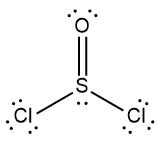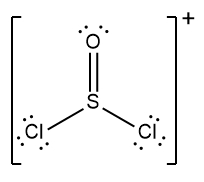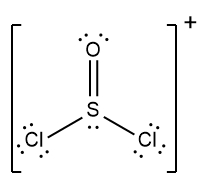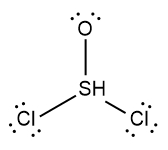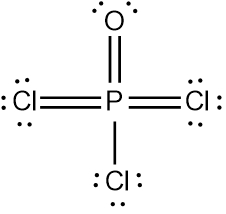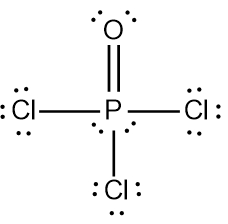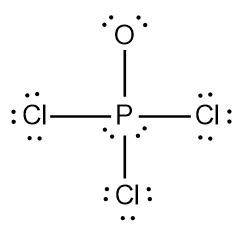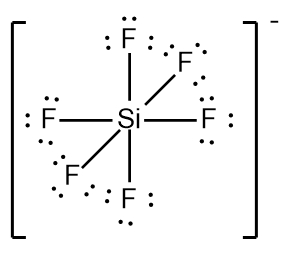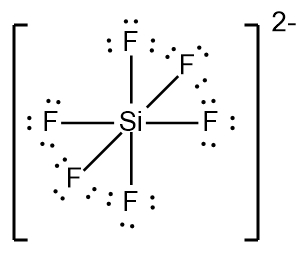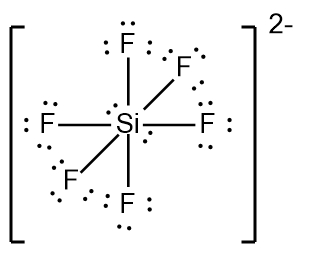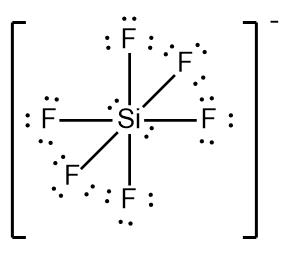Some elements can have less than 8 or more than 8 octet electrons around themselves and maintain stability. Now recall their non-octet number of electrons is \(2x\), their group number. So, for incomplete octets where they have less than 8 octet electrons around them, for group 2A it'd be \(2 \times 2\), which is 4. For group 3A it'd be \(3 \times 2\), which is 6. So, group 2A elements can have 4 octet electrons and be stable. Group 3A can have 6. We're just multiplying their group number by 2. So, group 5A could have 10 electrons and be okay, group 6A could have 12, 14, and 16. So, just remember, sometimes the octet rule is broken, and it's still okay in terms of the Lewis dot structure.
- 1. Matter and Measurements4h 29m
- What is Chemistry?5m
- The Scientific Method9m
- Classification of Matter16m
- States of Matter8m
- Physical & Chemical Changes19m
- Chemical Properties8m
- Physical Properties5m
- Intensive vs. Extensive Properties13m
- Temperature (Simplified)9m
- Scientific Notation13m
- SI Units (Simplified)5m
- Metric Prefixes24m
- Significant Figures (Simplified)11m
- Significant Figures: Precision in Measurements7m
- Significant Figures: In Calculations19m
- Conversion Factors (Simplified)15m
- Dimensional Analysis22m
- Density12m
- Specific Gravity9m
- Density of Geometric Objects19m
- Density of Non-Geometric Objects9m
- 2. Atoms and the Periodic Table5h 23m
- The Atom (Simplified)9m
- Subatomic Particles (Simplified)12m
- Isotopes17m
- Ions (Simplified)22m
- Atomic Mass (Simplified)17m
- Atomic Mass (Conceptual)12m
- Periodic Table: Element Symbols6m
- Periodic Table: Classifications11m
- Periodic Table: Group Names8m
- Periodic Table: Representative Elements & Transition Metals7m
- Periodic Table: Elemental Forms (Simplified)6m
- Periodic Table: Phases (Simplified)8m
- Law of Definite Proportions9m
- Atomic Theory9m
- Rutherford Gold Foil Experiment9m
- Wavelength and Frequency (Simplified)5m
- Electromagnetic Spectrum (Simplified)11m
- Bohr Model (Simplified)9m
- Emission Spectrum (Simplified)3m
- Electronic Structure4m
- Electronic Structure: Shells5m
- Electronic Structure: Subshells4m
- Electronic Structure: Orbitals11m
- Electronic Structure: Electron Spin3m
- Electronic Structure: Number of Electrons4m
- The Electron Configuration (Simplified)22m
- Electron Arrangements5m
- The Electron Configuration: Condensed4m
- The Electron Configuration: Exceptions (Simplified)12m
- Ions and the Octet Rule9m
- Ions and the Octet Rule (Simplified)8m
- Valence Electrons of Elements (Simplified)5m
- Lewis Dot Symbols (Simplified)7m
- Periodic Trend: Metallic Character4m
- Periodic Trend: Atomic Radius (Simplified)7m
- 3. Ionic Compounds2h 18m
- Periodic Table: Main Group Element Charges12m
- Periodic Table: Transition Metal Charges6m
- Periodic Trend: Ionic Radius (Simplified)5m
- Periodic Trend: Ranking Ionic Radii8m
- Periodic Trend: Ionization Energy (Simplified)9m
- Periodic Trend: Electron Affinity (Simplified)8m
- Ionic Bonding6m
- Naming Monoatomic Cations6m
- Naming Monoatomic Anions5m
- Polyatomic Ions25m
- Naming Ionic Compounds11m
- Writing Formula Units of Ionic Compounds7m
- Naming Ionic Hydrates6m
- Naming Acids18m
- 4. Molecular Compounds2h 18m
- Covalent Bonds6m
- Naming Binary Molecular Compounds6m
- Molecular Models4m
- Bonding Preferences6m
- Lewis Dot Structures: Neutral Compounds (Simplified)8m
- Multiple Bonds4m
- Multiple Bonds (Simplified)6m
- Lewis Dot Structures: Multiple Bonds10m
- Lewis Dot Structures: Ions (Simplified)8m
- Lewis Dot Structures: Exceptions (Simplified)12m
- Resonance Structures (Simplified)5m
- Valence Shell Electron Pair Repulsion Theory (Simplified)4m
- Electron Geometry (Simplified)8m
- Molecular Geometry (Simplified)11m
- Bond Angles (Simplified)11m
- Dipole Moment (Simplified)15m
- Molecular Polarity (Simplified)7m
- 5. Classification & Balancing of Chemical Reactions3h 17m
- Chemical Reaction: Chemical Change5m
- Law of Conservation of Mass5m
- Balancing Chemical Equations (Simplified)13m
- Solubility Rules16m
- Molecular Equations18m
- Types of Chemical Reactions12m
- Complete Ionic Equations18m
- Calculate Oxidation Numbers15m
- Redox Reactions17m
- Spontaneous Redox Reactions8m
- Balancing Redox Reactions: Acidic Solutions17m
- Balancing Redox Reactions: Basic Solutions17m
- Balancing Redox Reactions (Simplified)13m
- Galvanic Cell (Simplified)16m
- 6. Chemical Reactions & Quantities2h 35m
- 7. Energy, Rate and Equilibrium3h 46m
- Nature of Energy6m
- First Law of Thermodynamics7m
- Endothermic & Exothermic Reactions7m
- Bond Energy14m
- Thermochemical Equations12m
- Heat Capacity19m
- Thermal Equilibrium (Simplified)8m
- Hess's Law23m
- Rate of Reaction11m
- Energy Diagrams12m
- Chemical Equilibrium7m
- The Equilibrium Constant14m
- Le Chatelier's Principle23m
- Solubility Product Constant (Ksp)17m
- Spontaneous Reaction10m
- Entropy (Simplified)9m
- Gibbs Free Energy (Simplified)18m
- 8. Gases, Liquids and Solids3h 25m
- Pressure Units6m
- Kinetic Molecular Theory14m
- The Ideal Gas Law18m
- The Ideal Gas Law Derivations13m
- The Ideal Gas Law Applications6m
- Chemistry Gas Laws16m
- Chemistry Gas Laws: Combined Gas Law12m
- Standard Temperature and Pressure14m
- Dalton's Law: Partial Pressure (Simplified)13m
- Gas Stoichiometry18m
- Intermolecular Forces (Simplified)19m
- Intermolecular Forces and Physical Properties11m
- Atomic, Ionic and Molecular Solids10m
- Heating and Cooling Curves30m
- 9. Solutions4h 10m
- Solutions6m
- Solubility and Intermolecular Forces18m
- Solutions: Mass Percent6m
- Percent Concentrations10m
- Molarity18m
- Osmolarity15m
- Parts per Million (ppm)13m
- Solubility: Temperature Effect8m
- Intro to Henry's Law4m
- Henry's Law Calculations12m
- Dilutions12m
- Solution Stoichiometry14m
- Electrolytes (Simplified)13m
- Equivalents11m
- Molality15m
- The Colligative Properties15m
- Boiling Point Elevation16m
- Freezing Point Depression9m
- Osmosis16m
- Osmotic Pressure9m
- 10. Acids and Bases3h 29m
- Acid-Base Introduction11m
- Arrhenius Acid and Base6m
- Bronsted Lowry Acid and Base18m
- Acid and Base Strength17m
- Ka and Kb12m
- The pH Scale19m
- Auto-Ionization9m
- pH of Strong Acids and Bases9m
- Acid-Base Equivalents14m
- Acid-Base Reactions7m
- Gas Evolution Equations (Simplified)6m
- Ionic Salts (Simplified)23m
- Buffers25m
- Henderson-Hasselbalch Equation16m
- Strong Acid Strong Base Titrations (Simplified)10m
- 11. Nuclear Chemistry56m
- BONUS: Lab Techniques and Procedures1h 38m
- BONUS: Mathematical Operations and Functions47m
- 12. Introduction to Organic Chemistry1h 34m
- 13. Alkenes, Alkynes, and Aromatic Compounds2h 12m
- 14. Compounds with Oxygen or Sulfur1h 6m
- 15. Aldehydes and Ketones1h 1m
- 16. Carboxylic Acids and Their Derivatives1h 11m
- 17. Amines38m
- 18. Amino Acids and Proteins1h 51m
- 19. Enzymes1h 37m
- 20. Carbohydrates1h 46m
- Intro to Carbohydrates4m
- Classification of Carbohydrates4m
- Fischer Projections4m
- Enantiomers vs Diastereomers8m
- D vs L Enantiomers8m
- Cyclic Hemiacetals8m
- Intro to Haworth Projections4m
- Cyclic Structures of Monosaccharides11m
- Mutarotation4m
- Reduction of Monosaccharides10m
- Oxidation of Monosaccharides7m
- Glycosidic Linkage14m
- Disaccharides7m
- Polysaccharides7m
- 21. The Generation of Biochemical Energy2h 8m
- 22. Carbohydrate Metabolism2h 22m
- 23. Lipids2h 26m
- Intro to Lipids6m
- Fatty Acids25m
- Physical Properties of Fatty Acids6m
- Waxes4m
- Triacylglycerols12m
- Triacylglycerol Reactions: Hydrogenation8m
- Triacylglycerol Reactions: Hydrolysis13m
- Triacylglycerol Reactions: Oxidation7m
- Glycerophospholipids15m
- Sphingomyelins13m
- Steroids15m
- Cell Membranes7m
- Membrane Transport10m
- 24. Lipid Metabolism1h 45m
- 25. Protein and Amino Acid Metabolism1h 37m
- 26. Nucleic Acids and Protein Synthesis2h 54m
- Intro to Nucleic Acids4m
- Nitrogenous Bases16m
- Nucleoside and Nucleotide Formation9m
- Naming Nucleosides and Nucleotides13m
- Phosphodiester Bond Formation7m
- Primary Structure of Nucleic Acids11m
- Base Pairing10m
- DNA Double Helix6m
- Intro to DNA Replication20m
- Steps of DNA Replication11m
- Types of RNA10m
- Overview of Protein Synthesis4m
- Transcription: mRNA Synthesis9m
- Processing of pre-mRNA5m
- The Genetic Code6m
- Introduction to Translation7m
- Translation: Protein Synthesis18m
Lewis Dot Structures: Exceptions (Simplified) - Online Tutor, Practice Problems & Exam Prep
 Created using AI
Created using AISome elements can have fewer or more than 8 electrons in their valence shell and still be stable, breaking the octet rule. For example, group 2A elements can have 4 electrons, while group 3A can have 6. Free radicals, which are molecules with an unpaired electron, always have an odd number of total valence electrons. For instance, nitrogen monoxide has 11 valence electrons, confirming its status as a radical. Understanding these concepts is crucial for grasping molecular stability and reactivity.
Lewis Dot Structure Exceptions happen when the central element violates the Octet Rule.
Lewis Dot Structure Exceptions
Lewis Dot Structures: Exceptions (Simplified) Concept 1
Video transcript
Group 2A and 3A elements have incomplete octets. Group 5A-8A elements can have expanded octets.
Lewis Dot Structures: Exceptions (Simplified) Example 1
Video transcript
Here we have to draw the Lewis dot structure for the xenon dibromide molecule. So, xenon is in group 8A; it's a noble gas. It has 8 valence electrons. Bromine is in group 7A, so it has 7, and there are 2 of them. So, we have a total of 22 valence electrons. Now, xenon will go in the center, and here we're going to be connected to our 2 bromines. Now remember, your surrounding elements need to follow the octet rule. So, we're going to put our electrons around bromines so that they each have 8 total valence electrons. Three lone pairs around them totaling 6 electrons. Remember, they're also sharing electrons from the single bond, so each one has 8. That's using up 16 of my total 22 valence electrons. So, we have 6 remaining. Here, the remaining 6 electrons, we have no choice, but to put them around xenon. So, 6 electrons and we separate them evenly as lone pairs, and this would be the structure of a xenon dibromide molecule. We can see here that xenon has 2, 4, 6, 8, 10 electrons around it. It's breaking the octet rule because it is an exception. Now, its ideal non-octet number would have been 16, but again, that's when it's ideal. Here, we just don't have enough electrons to get to that number of 16. Instead, xenon is okay with having 10 electrons around it. But here we're seeing that our central elements are breaking the octet rule, and it's still okay.
Determine the Lewis Dot Structure for the following compound:SOCl2
Lewis Dot Structures: Exceptions (Simplified) Concept 2
Video transcript
When we discuss electron molecules, we typically talk about free radicals. Now free radicals are molecules or ions with a single unpaired electron around an element. We're going to say that these radical compounds or radical molecules always have an odd number of total valence electrons. What's important to understand here is that to draw them, we place the electron on the element that is less electronegative, except in the case of hydrogen itself. That's because if we show a similar electron around hydrogen, it would be breaking the octet rule, or in this case, the duet rule where it wants only 2 electrons around it.
So if we take a look here at this molecule of nitrogen monoxide, we have a lone electron here that's unpaired on the nitrogen. Nitrogen is less electronegative than oxygen, so that's why it has the lone electron. And how do we know that nitrogen monoxide is a radical compound? Again, we would look at the total number of valence electrons and see if it's an odd number. Nitrogen is in group 5a, so it has 5 valence electrons. Oxygen's in group 6a, so it has 6 valence electrons. So the total number of valence electrons for nitrogen monoxide is 11 electrons. It's an odd number and that's why we have a radical molecule or compound in this case. So just keep in mind when we deal with these radical or free radical compounds, this is what you need to be on the lookout for to determine if it is a radical or not.
Radical compounds always have an odd number of total valence electrons.
Lewis Dot Structures: Exceptions (Simplified) Example 2
Video transcript
Here it says draw the Lewis dot structure for the radical of nitrogen dioxide. So, nitrogen dioxide is a very common example used to talk about radicals. If we look at the total number of valence electrons, we have 5 from nitrogen since it's in group 5A, 6×2, oxygen's in group 6A, so it has 6 and there are 2 of them. This has a total of 17 total valence electrons. It's an odd number of valence electrons, so that's a strong indication we're dealing with a radical. We place nitrogen in the center; it forms single bonds to the oxygens initially, make sure that your surrounding elements follow the octet rule. Right now, we have a total of 16 electrons being depicted, leaving us with 1 electron left. The issue now is that nitrogen is not fulfilling the octet rule. It has 2, 3, 5 electrons around it. So, remember when an element is not fulfilling the octet rule, what we can do is make double or triple bonds. Here we can't make a triple bond because then that'd be too many electrons around nitrogen. It can only go up to 8 for the octet rule. So, we're just gonna use one of the lone pairs on oxygen, either one, to make a double bond. And in that way, nitrogen has 7 electrons around it. And that's the best that we can do. This here depicts what the nitrogen dioxide molecule would look like. It is a radical because we have that one lone electron on nitrogen.
Draw the Lewis Dot Structure for the radical hydroxide, OH.
Draw the Lewis Dot Structure for POCl3.
Metalloids can sometimes adopt the bonding preferences of similar nonmetals. Based on your knowledge of expanded octets, draw the Lewis Dot Structure for the following ion, SiF62–.
Do you want more practice?
Here’s what students ask on this topic:
What are the exceptions to the octet rule in Lewis dot structures?
Some elements can have fewer or more than 8 electrons in their valence shell and still be stable, breaking the octet rule. For example, group 2A elements can have 4 electrons, while group 3A can have 6. Additionally, elements in groups 5A and 6A can have 10, 12, 14, or even 16 electrons. These exceptions occur because the elements can either have incomplete octets or expanded octets, depending on their group number and the availability of d-orbitals for bonding.
 Created using AI
Created using AIHow do you determine if a molecule is a free radical?
To determine if a molecule is a free radical, check if it has an odd number of total valence electrons. Free radicals are molecules or ions with a single unpaired electron. For example, nitrogen monoxide (NO) has 11 valence electrons: 5 from nitrogen (group 5A) and 6 from oxygen (group 6A). Since 11 is an odd number, NO is a free radical. The unpaired electron is typically placed on the less electronegative element, except for hydrogen, which follows the duet rule.
 Created using AI
Created using AIWhy can some elements have more than 8 electrons in their valence shell?
Some elements can have more than 8 electrons in their valence shell due to the availability of d-orbitals for bonding. This is common in elements from period 3 and beyond in the periodic table. For instance, sulfur in SF6 has 12 valence electrons. These expanded octets occur because the d-orbitals can accommodate additional electrons, allowing the element to form more bonds and achieve greater stability.
 Created using AI
Created using AIWhat is the significance of free radicals in chemistry?
Free radicals are significant in chemistry because they are highly reactive due to the presence of an unpaired electron. This reactivity makes them important in various chemical reactions, including combustion, polymerization, and biological processes like DNA damage and repair. Understanding free radicals helps in studying reaction mechanisms and developing antioxidants that can neutralize these reactive species.
 Created using AI
Created using AIHow do you draw the Lewis dot structure for a molecule with an incomplete octet?
To draw the Lewis dot structure for a molecule with an incomplete octet, first determine the total number of valence electrons. Then, arrange the electrons to satisfy the octet rule for as many atoms as possible, starting with the most electronegative atoms. For example, in BF3, boron (group 3A) has 3 valence electrons, and each fluorine (group 7A) has 7 valence electrons. The total is 24 valence electrons. Boron will have only 6 electrons around it, forming three single bonds with fluorine atoms, resulting in an incomplete octet for boron.
 Created using AI
Created using AI